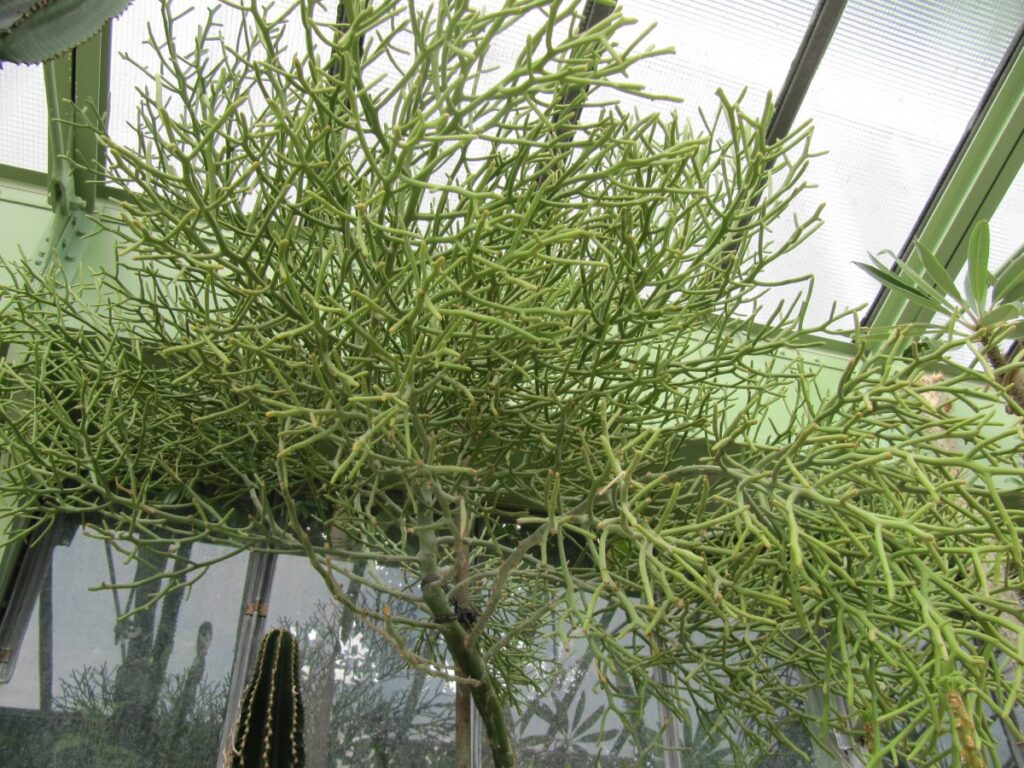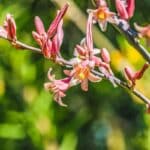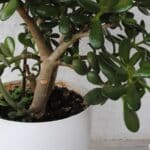A remarkable plant with an apt name, the Candelilla is one of those succulents that will light up any houseplant or garden collection.
It is versatile and holds an exceptional form that sets it apart from the rest of its group of plants. It also possesses utilitarian properties that make it such an invaluable succulent to own.
If you have this succulent or plan to add it to your collection, here is a guide on how to grow and care for this unique Euphorbia.
What is a Candelilla Plant?
Candelilla is a Spanish word that means “little candles.” This was given as a common name to Euphorbia Cerifera because of the waxy slender, candle-like foliage-free stems. This may be confused with another plant from a different group, Pedilanthus macrocarpus, which is also given the same common name. The plant was initially and still popularly called E. antisyphilitica in reference to its medicinal properties.
Another name for E. Cerifera is Wax Euphorbia owing to its extractable wax material harvested from the plant which has several uses. It originated from the Chihuahuan Desert of Mexico and Texas and thrives in rocky and pebbled areas where limestone is rich (1).
The plant is a small evergreen shrub reaching up to a meter in height and spread despite the shallow and short root system. From afar, the stems look like upright grayish-green leaves of tall grasses. Although considered leafless, Candelilla produces tiny leaves that fall easily and are rarely observed. From spring to summer, small star-shaped white individual flowers with red centers appear terminally along the thin stems (2).

What are the Growth Requirements of a Candelilla?
As a desert plant, this Euphorbia is extremely tolerant of full sunlight and heat. Thanks to the wax that regulates the evaporation process in the plant, it can withstand long periods of low atmospheric and soil moisture during summer and is hardy to up to 28 °F.
Regular, albeit infrequent watering is necessary to promote the spread of the Euphorbia Cerifera plant, especially in a landscape. As a houseplant, Candelilla requires amending the soil with lime and adapts to alkaline conditions. (2)
How to Propagate and Care for Wax Euphorbia
Wax Euphorbia can develop 100 stems or more in a clumped manner. This creates a compact grass-like appearance that looks outstanding in narrow planter boxes and desert or rock and succulent-themed gardens.
In a span of 3 to 5 years, the plant will form clusters, especially in the garden. Pruning is not necessary, but it will benefit from division or separation to allow the plant to breathe as well as to remove unwanted dead stems. Propagules can be obtained from the divided stems and can be planted as individual plants (3).
In general, the wax plant will benefit from a soil mixture leaning on higher rocky materials. For acclimated Candelillas, a south-facing location in the garden or indoors provides the plant with the sunshine it needs and protection from high heat levels. Like most succulents and cacti, it will need protection from frost come winter.
When considering growing with other plants, the Wax Euphorbia is often paired with ocotillo, Chinese grass, and prickly lettuce which share the same requirement and complements each other’s growth and appearance (4).
In the wild, browsing deer and rabbits cause damage but only occasionally. The Candelilla plant is resistant to pests and diseases but is not exempted from infrequent mites and aphids attacks which can be treated with mild soap and water solution.
What are the Other Uses of E. Cerifera?
As with most Euphorbias, Candelilla produces a version of the milky latex that serves as the plant’s defense mechanism in the wild. In Mexico, this latex, in the form of a thick wax coating the stems, has economic importance. It is commercially harvested, boiled, and utilized in making wax polish, candles, soap, ointment, and waterproofing among others (4).
The old scientific name of the plant E. antisyphilitica is an acknowledgment of the plant’s properties used in treating venereal diseases. The extract of the plant is traditionally used by the natives to treat syphilis. Other uses of the wax include chewing gum additives and cosmetics and culinary ingredients.
Because of the diverse utilization of the raw material from this plant, it has been over-harvested in its natural habitat putting Candelilla under threatened status (5).
Is Candelilla Toxic?
The Wax Euphorbia is categorized as non-toxic and can be grown indoors. However, the latex that the plant secretes may cause skin irritation in excessive amounts, especially to people with sensitive skin. It is recommended to use protective gear like gloves when handling the plant.
FAQs
What is Euphorbia plant good for?
Euphorbia plants, which comprise a large and diverse genus, have various uses and benefits. Some Euphorbia species are grown for ornamental purposes, adding aesthetic value to gardens and landscapes. Euphorbia resin (latex) from certain species is used traditionally in herbal medicine for treating various ailments. Additionally, some species, like Euphorbia tirucalli, are used for biofuel production.
Is Euphorbia Cerifera candelilla wax safe?
Yes, candelilla wax derived from Euphorbia Cerifera is generally considered safe. It is commonly used in cosmetics, food products, and other applications as a vegan alternative to beeswax. However, as with any substance, individual sensitivities may vary, so it’s advisable to check for specific product information and consult with relevant experts if needed.
For more cool plants to grow, check these unusual succulents.
References
Reference List:
(1) Desert Ecology. Candelilla.
(2) Aggie Horticulture. Candelilla, Wax Euphorbia. Texas Native Shrubs. https://aggie-horticulture.tamu.edu/ornamentals/nativeshrubs/euphorbiaantisyphil.htm. Accessed 31. March 2021.
(3) Arizona State University. Euphorbia antisyphilitica. 2021.
(4) Candelilla Institute. Candelilla Plant. 2013
(5) Plants for a Future. Euphorbia antisyphilitica-Zucc. 2005
Close
*Featured photo used with permission by Leonora (Ellie) Enking | Flickr (CC BY-SA 2.0)






